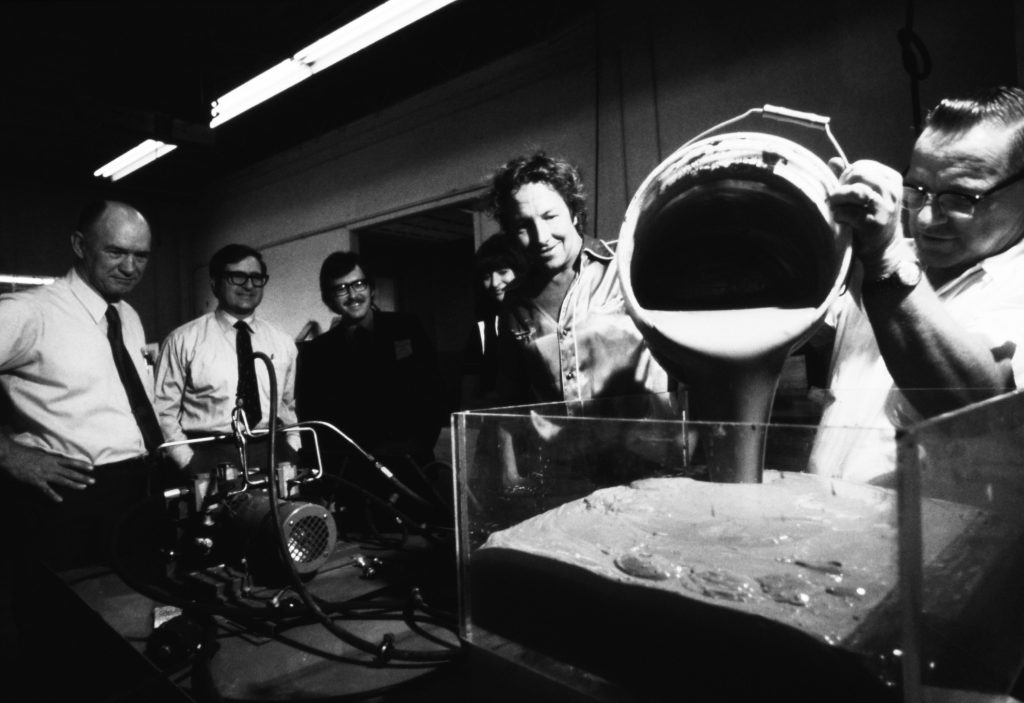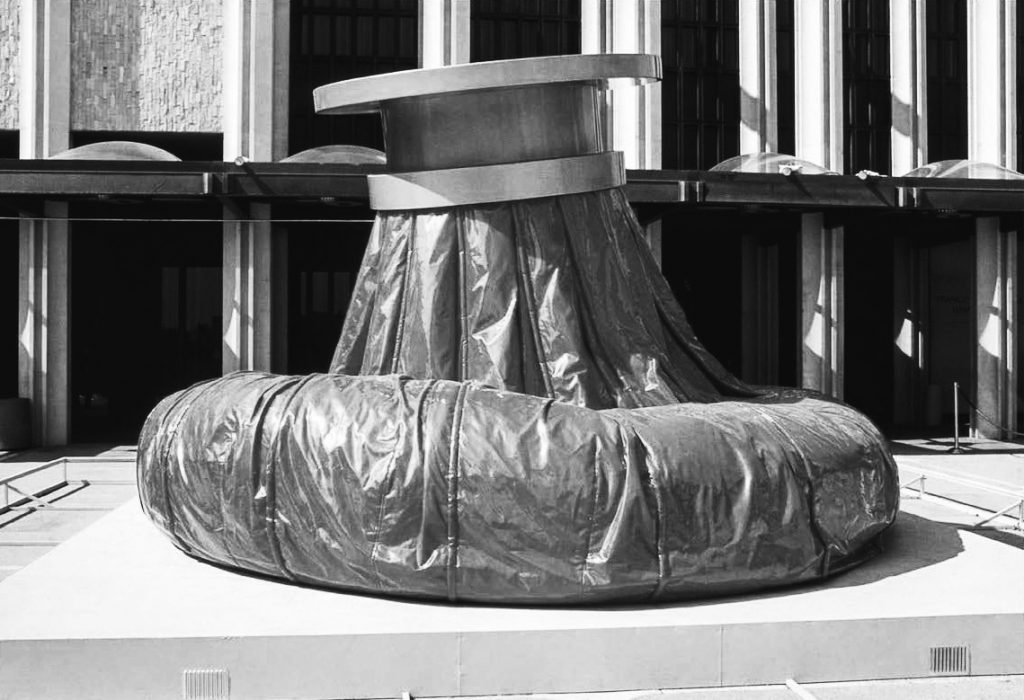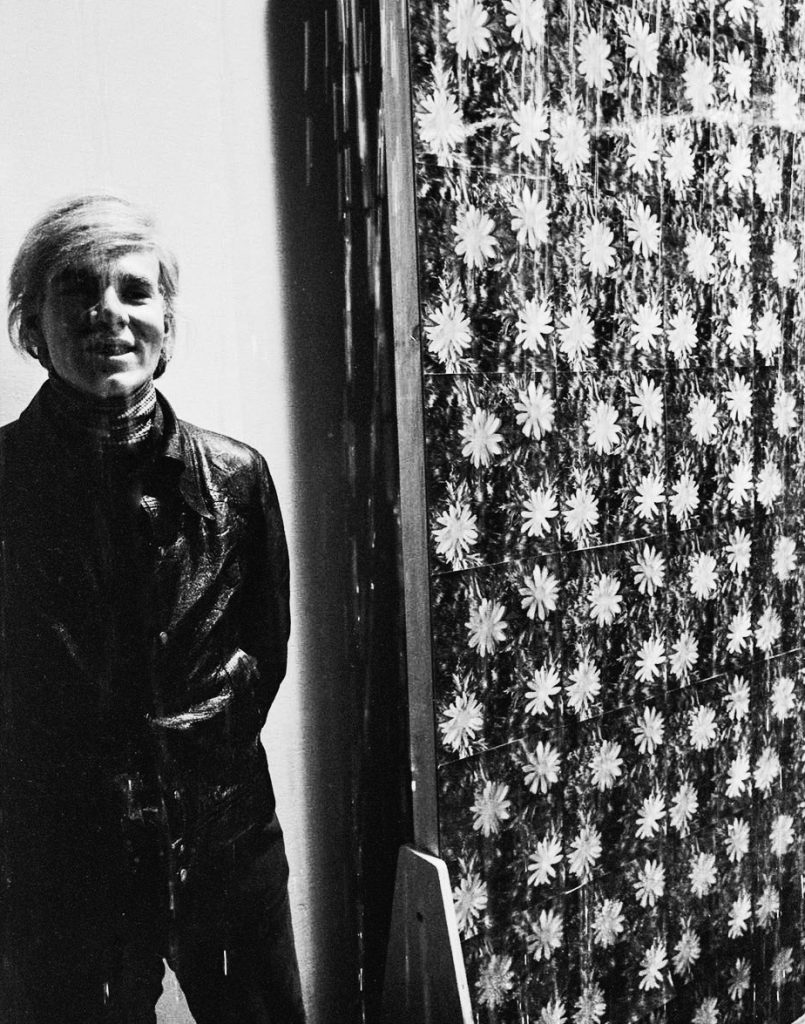Cal Tech
From the Archives: Art and Technology at LACMA, 1967–1971
Los Angeles County Museum of Art
21.03.15 – 25.10.15
Joint Second Prize Winner
Entry in English
The Treachery of Images ( 1929 ) is among the most iconic pictures produced in the twentieth century, but most people don’t know that this metatextual painting by René Magritte, depicting a pipe above the phrase ‘Ceci n’est pas une pipe’, is in the permanent collection of the Los Angeles County Museum of Art. It’s an ideal holding for the region’s largest and most comprehensive institution: the wit presages John Baldessari, the typography Ed Ruscha; the Foucauldian slippage between the real and the imaginary – well, that’s how SoCal rolls. The painting is also one of the last works you see before arriving at From the Archives: Art and Technology at LACMA, 1967–1971, commemorating the pioneering exhibition launched by LACMA curator Maurice Tuchman, to ‘bring together the incredible resources and advanced technology of industry with the equally incredible imagination and talent of the best artists at work today’. Like Magritte’s painting, ‘Art and Technology’, aka A&T, has had a resurgent afterlife.
Tuchman joined LACMA in 1964 as a transplant from New York, and he initiated A&T two years after his arrival to harness the futureforward, technopositive ethos in his new town. The exhibition revolved around an elaborate programme to embed blue-chip artists – including Andy Warhol, Robert Rauschenberg, Robert Irwin and James Turrell – within corporations such as Lockheed, IBM, Ampex and Kaiser Steel, as well as entertainment companies and research centres including Universal Studios and the Jet Propulsion Laboratory. Tuchman’s ambition extended to unprecedentedly broad showcases: eight of the projects – including Newton Harrison’s kinetic gas-plasma light works and Tony Smith’s corrugated cardboard ‘cave’ – were previewed by more than ten million visitors at Expo ’70 in Osaka.
LACMA’s mini-retrospective offers a fine grained, behind-the-scenes look at the programme as it unfolded. Materials on view include records of the sometimes antagonistic relationships between the artists and the corporations, such as the combative missives between the trickster John Chamberlain and an increasingly intolerant collection of Rand Corporation technocrats: ‘I’m searching for answers. Not questions!’ ‘There is only one answer. You have a… warped, trashy idea of what beauty and talent is.’ The show also provides a reminder of the bubbling creative energy that propelled the programme, as well as of its sheer eccentric originality: sketches and photos of Öyvind Fahlström’s Zap Comix-inspired coated metal Meatball Curtain ( for R. Crumb ) ( 1969 ) are shown alongside newly remastered footage of Claes Oldenburg sketching blackboard drawings for his Giant Ice Bag ( 1969–70 ), an oversize kinetic soft sculpture that continuously inflates and deflates.
What the retrospective does not have room to do, however, is explain how A&T – long considered by many as a failed experiment – achieved its now paradigmatic position. One is left to wonder about the historical reception of the programme and the broader context of the global boom in art and technology collaborations in the 1960s. Understanding A&T’s long and seemingly unlikely rise to its current iconic status requires a closer examination of its relationship to Southern California’s economy and culture.
The fundamental problem facing Tuchman was that the nation’s attitudes towards technology transformed between 1966, when he first proposed A&T, and 1971, when the programme opened. Throughout the mid-1960s, technology carried the sheen of modernity, with figures such as R. Buckminster Fuller, Marshall McLuhan and Nam June Paik expressing utopian aspirations for expanded modes of communicating and new ways of living. By the early 1970s, however, artists, audiences and even museum patrons had turned against the war in Vietnam, and technology had become synonymous with the military-industrial complex. In a 1971 review, Max Kozloff expressed contempt for the artists who ‘did not hesitate to freeload at the trough of that techno-fascism that had inspired them’. If geopolitics confounded A&T, so, too, did identity politics. As many noted, the cover of the 1971 catalogue is a grid of head shots of the participating artists and engineers: all white, all male. The artists are shaggy, the engineers buttoned down, but that’s it for diversity. A&T was so egregiously patriarchal that it prompted the formation of the Los Angeles Council of Women Artists, and so uniformly Anglo that it was one of the tipping points leading to the Chicano/Chicana collective Asco’s famous intervention, Spray Paint LACMA, in 1972.
How is it possible, then, that a few decades later A&T has achieved cult status? The answer is simply that the original A&T went viral long ago and still hasn’t left Southern California’s system. Indeed, conditions have long been just right for a techno pandemic in Southern California. Local art fabricators like Jack Brogan and Peter Carlson were patient zero: from Brogan’s work with Light and Space and Finish Fetish artists in the 1960s and 1970s, to Carlson’s partnering on contemporary sculpture with Charles Ray, Liz Larner and Doug Aitken, the region’s fabricators have introduced everything from auto detailing to injection moulding to surfboard glassing into fine arts practice, extending the A&T model into a new role of fabricator as co-creative spirit.
The A&T virus infects not just works but also spaces. While MIT’s Center for Advanced Visual Studies and the Exploratorium in San Francisco are also legacies of the 1960s art/tech boom, it was in Southern California that the innate hybridity of the A&T process mutated the art world enough to alter the very mechanics of viewing and display. While the original A&T was a hierarchical affair, its descendants are more feral, egalitarian and hackerish. True to A&T, these venues often embrace an engineering sensibility as much as an artistic one, favouring the ‘kludge’ – an engineer’s term for a quick and dirty workaround – over the fixed solution. They are also resolutely idiosyncratic outgrowths of their founders’ obsessions, which are themselves usually rooted more in science ( or at least sci-fi ) than in art history. There is the justly famous Museum of Jurassic Technology, and right next door, CLUI, Matthew Coolidge’s Center for Land Use Interpretation, which extends land art to include, say, exhibitions of experimental aircraft crash sites of the Mojave. The Crochet Coral Reef project may be the most seductive output of sisters Margaret and Christine Wertheim’s Institute For Figuring, but the IFF also curates shows on fringe physics and alternative logic alphabets.
Most directly channelling A&T is Echo Park’s Machine Project, which falls on a continuum spanning twenty-first-century maker spaces, self-sustaining relational-aesthetic experiments, and sui generis SoCal eccentricities. Founded and directed by Mark Allen, Machine Project hosts everything from hackathons that explore the programming of Arduino robotic controllers, to workshops on DIY cat architecture. Allen acknowledges his debt to A&T, especially those projects where the artist came to master the technology him or herself, rather than relying on help from technologists. Yet there is also an evolution of the A&T legacy: the critic and painter Peter Plagens maintained that A&T was about ‘hardware’, whereas Machine Project tends towards software, if only because it is more easily distributable and encourages a DIY spirit.
While Robert Irwin claimed that A&T was a red herring because it gave technology equal billing with art, LACMA’s director, Michael Govan, maintains that the show opened the possibility of understanding technology poetically. But beyond the realm of art, A&T acted as both a reflection and an agent of change on the culture of technology itself. A&T was part of a much broader transformation that is tied specifically to the intersection of West Coast counterculture with the new spirit of entrepreneurial capitalism that sprang up in Silicon Valley. Engineers in California don’t present as straitlaced company stooges anymore. Today’s ‘creative industries’ employ coders who look, and claim to think, like artists. Art, or at least artifice, has hybridised with technology; that mutant has come to dominate our culture and has taken over our workplaces, our home lives, and even our bacchanalias.
Take the annual Coachella Valley Music and Arts Festival, which has tricked out A&T’s legacy in a throbbing pop-glitz festival idiom, less Burning Man and more TechCrunch Disrupt. In 2015 the standout was the mesmerising Hypercube projection that formed the four-dimensional stage for LA-based producer Flying Lotus ( Steven Ellison ), enshrouding the artist in a pulsating series of animated characters, colours and graphics that pushed the boundaries of expanded cinema, augmented reality and sheer spectacle to jaw- and bass-dropping limits: pulsating proof of William Gibson’s quip that ‘the future is already here, it’s just not evenly distributed yet’. If Coachella’s reliance on corporate sponsors retreats from the contemporary DIY spirit back into the hierarchies of the original A&T, the festival also gives way to another kind of consumption. In addition to sound and light, Coachella features the gourmet-food trucks that have come to define Southern California’s culinary landscape. Chef Roy Choi’s Kogi truck has pride of place at the desert festival; it also regularly occasions a long line outside LACMA during lunch hours, where it offers urSoCal Korean–Mexican fusions such as bulgogi tacos and kimchi quesadillas. In a sense his kitchens on wheels are geo-locative, streetscape-activating, mobile sites of production and consumption, rolling from the mountains to the valleys, from the desert to the sea. How very A&T.
加州技术
“出自档案:LACMA的‘艺术和技术’1967-1971”
洛杉矶郡艺术博物馆
2015年3月21日2015年10月25日
并列二等奖
中文投稿
《图像的变节》( 1929 )是二十世纪最为讽刺的图画之一,但大部分人不知道这幅来自热内马格利特( René Magritte )的画作是洛杉矶郡艺术博物馆( LACMA )的馆藏,这个元文本式的作品描绘了一个烟斗,下面是一句话“这不是一只烟斗”。这幅画对于一个地区中最大最全面的艺术机构来说是一个理想的藏品,它的智慧启发了约翰巴尔代萨里( John Baldessari ),它的文字启发了埃德茹谢( Ed Ruscha ),还有它那位于真实和想象之间、福柯意味的滑移金这些都是南加州的特点。这幅画同时也是展览“出自档案:LACMA的‘艺术和技术’,1967-1971”中观众看到的最后一个作品。这个展览主要回应了LACMA策展人莫里斯特克曼( Maurice Tuchman )之前的一个先驱性的展览,那个展览“将‘不可思议的资源及先进的工业技术’与‘同等不可思议的想象力及当今最具天赋的艺术家’带到了一起”。正如马格利特的画作,“艺术和技术”( 又被简称为” )后继有人。
特克曼1964年从纽约搬来,加入了LACMA,他在两年后开始准备”项目,以此来获取与这座目光朝向未来、技术乐观主义的新城市的联系。当时,展览围绕着非常详尽的议程,将蓝筹股艺术家金包括安迪沃霍尔、罗伯特劳申伯格、罗伯特厄文及詹姆斯特瑞尔金与诸如洛克希德、IMB、安派克斯、凯撒钢铁厂等企业融汇在一起,还有一些娱乐公司和研究中心,譬如环球影城和喷气推进实验室。特克曼的目标延伸到了前所未有的广度,展览中的八个项目金包括了牛顿哈里森( Newton Harrison )的气体动能等离子灯光作品和托尼史密斯( Tony Smith )的硬纸板作品《洞》金都在1970年大阪世博会时接待了一千多万名预览参观者。

Robert Rauschenberg( second from right ), engineers from Teledyne, and LACMA curators Maurice Tuchman and Gail Scott( third and fourth from left ) viewing a prototype model for Rauschenberg’s Art and Technology piece Mud Muse, 1970. ©2015 Robert Rauschenberg Foundation/Licensed by VAGA, New York, NY. Photo ©Malcolm Lubliner. 罗伯特·劳森伯格( 右二 )、来自特利丹的工程师以及洛杉矶郡立美术馆两位策展人莫里斯·图赫曼( 左三 )和盖尔·斯科特( 左四 )正在观看罗伯特·劳森伯格的“艺术与科技”作品的原型:Mud Muse,1970。照片来源:罗伯特·劳森伯格基金会.
LACMA的迷你回顾展为71年的展览提供了纹理清晰的后台视角。展出的材料包括了艺术家与企业之间时而对立的关系,比如魔术师约翰张伯伦( John Chamberlain )和日益不耐烦的兰德公司技术专家之间的火药味:“我在找答案,不是找问题。塘只有一个答案:你对于美和天赋有着扭曲的垃圾看法。”回顾展览还指出了原展览中对于膨胀的创造能量的依赖,以及古怪的原创性:欧文德法尔斯特洛姆( Öyvind Fahlström )1969年受到漫画启发的镀金作品《肉丸帘( 给R科伦波 )》的手稿和照片,旁边放着克拉斯欧登柏格( Claes Oldenburg )《大冰袋》( 1969-1970 )的黑板速写图稿,那是一个动力软雕塑,不断地膨胀和萎缩。
这次回顾展没有做到位的,是向观众解释为什么长久以来被视为一次失败的展览现在却成为了示范性展示。回顾展并未给观众铺设”的历史反响,以及60年代在全球范围内涌现的艺术和科技合作的语境。”获得今天的标志性地位经历了漫长而出乎意料的过程,为了理解这个过程,我们需要对南加州的经济和文化进行深入的考察。

Claes Oldenburg’s Giant Ice Bag ( 1969–70 ), installed at LACMA in 1971. © Claes Oldenburg, Photo © Museum Associates/LACMA. 克莱斯·奥登伯格的《大冰袋》( 1969-1970 ,1971年被安装于LACMA,©Claes Oldenburg 摄影©Museum Associates/LACMA.
特克曼在当时面临的根本问题是国家对技术的态度在1966年( 他第一次提出&T” )与1971年( 展览开幕 )之间经历了转变。在60年代中期,技术为人们带来了现代性的光芒,诸如R伯克敏斯特( R. Buckminster Fuller )、马尔肖麦克卢汉( Marshall McLuhan )和白南准( Nam June Paik )等人物对扩展通信模式和新生活方式表达了乌托邦愿望。然而,到了70年代初,艺术家、观众,甚至博物馆的资助者都站在了反对越战的一边,技术在当时成为了军事工业综合体的代名词。在一篇1971年的评论中,马克斯科兹洛夫( Max Kozloff )对那些“在启发他们的技术法西斯主义面前毫不犹豫,不劳而获”的艺术家不屑一顾。如果说&T”在地缘政治层面受到了挫败,那么在身份政治层面亦然。正如许多人指出,1971年出版的展览画册封面是参与艺术家和工程师的头像网格:清一色的白人男性。艺术家都有点邋遢,而工程师都穿件衬衫,这个展览在多样性上也就如此。&T”体现出的父权制异乎寻常,而正是这个展览促使了洛杉矶女性艺术家委员会的成立;而人员一律是盎格鲁白人的展览也导致了另一个转折点金拉丁美洲裔艺术小组Asco1972年在LACMA的干预喷漆作品。
那么,几十年后,&T”何以达到它今天那令人膜拜的地位呢? 答案很简单,原来的&T”病毒在很久以前就流行开了,而且并没有离开南加州的系统。 事实上,南加州长期以来一直拥有流行技术病的绝佳环境。 当地的艺术品制作商都很耐心,比如杰克布罗根( Jack Brogan )和彼得卡尔森( Peter Carlson )。从60和70年代布罗根的“光与空间”( Light and Space )和“拜物”( Finish Fetish )运动中艺术家的工作,到卡尔森与查尔斯雷( Charles Ray )、莉兹拉尔纳( Liz Larner )和道格埃特肯( Doug Aitken )等艺术家的当代雕塑合作, 地区内的制作商为艺术实践引入了一切可能的技术:从汽车细节工艺到注塑成型,再到冲浪板玻璃,光这一点,就将&T”模型进行了延伸:它为艺术制作商赋予了共同创造的新角色。
“A&T”病毒不仅感染艺术作品,而且感染空间。虽然麻省理工学院的高级视觉研究中心和旧金山的探索馆也是60年代艺术/科技热潮的产物,但是在南加州,&T”进程中所具有的先天性杂交基因使艺术界产生了突变效应,足以更改旧有的观看和展示机制。虽然原本的&T”等级层次分明,但它的后裔更加勇猛,更加的平等主义和黑客式的。这些场馆忠于&T”精神,它们对于工程敏度的热情与对于艺术敏度的一样多,对于”( 组装机 )金对工程师来说是一个草率和肮脏的解决方案金的钟爱与对于单一答案的一样多。他们也坚定地延续了前辈所具有的痴迷,这种痴迷更多地植根于科学( 或至少是科幻小说 ),而非艺术史。南加州有一个著名的侏罗纪科技博物馆,它的隔壁是马修柯立芝( Matthew Coolidge )的土地使用解释中心( CLUI ),这个机构拓展了大地艺术,使之包含了诸如莫哈韦实验飞机坠毁现场的展览。“钩编珊瑚礁”项目可能是玛格丽特和克里斯蒂娜韦特海姆姐妹( Margaret and Christine Wertheim )的图像研究所( IFF )最具魅力的产物,而IFF还策划过关于边缘物理和替代逻辑字母的展览。

Andy Warhol standing next to a prototype for his Art and Technology piece Rain Machine, 1969. Artwork executed in collaboration with Cowles Communication under the auspices of the Art and Technology programme at LACMA, 1967–71.安迪·沃霍尔站在他的“艺术与技术”展览作品“下雨机器”的原型旁边,1969年。这件作品是在“艺术与技术”展览安排下在1967-1971年期间与考雷斯通讯公司合作完成的。
“A&T”中最直接明了的例子是回声公园( Echo Park )的“机器项目”,这是一个跨越二十一世纪创造者空间的连续机体、一个自足自给的关系美学实验,以及自成一体的南加州奇妙产物。 “机器项目”由马克艾伦( Mark Allen )创立并执行,其中包括了从专门研究Arduino机器人控制器编程的黑客松,以及DIY猫咪建筑的工作坊。艾伦承认他深受&T”影响,特别是那些艺术家自己掌握技术而不是靠专家帮忙的项目。 然而,&T”遗产也有演变:评论家和画家彼得普拉根斯( Peter Plagens )认为&T”是关于“硬件”,而“机器项目”则更像是软件,因为它更适于传播,并鼓励DIY精神。
虽然罗伯特厄文声称&T”是一条红色鲱鱼,因为它对技术的重视等同于艺术,但LACMA馆长迈克尔葛文( Michael Govan )希望这个展览打开诗意地理解技术的可能性。 然而在艺术领域之外,&T”既是技术本身的文化反映,也是它发展变革的能动力。“ A&T”是更广泛的社会转型的一部分,特别是西海岸反文化与硅谷涌现的创业资本主义新精神的交叉。 加州的工程师们不再是一本正经的公司员工,今天的“创意产业”已经开始雇佣那些看起来像是、并自称“像艺术家一样思考”的编程人员。 艺术,或至少是技艺,已与技术杂交;而这个突变体已成为我们文化的主宰,占据了我们的工作场所、家庭生活,甚至我们的派对和狂欢。
以一年一度的Coachella Valley音乐艺术节为例,它将&T”的遗产装扮成为了一种悸动的流行音乐节范式,它只不过比”大会更加不像“火烧人”一点。在2015年的音乐节上,最迷人的莫过于洛杉矶制作人“飞天莲花”( Flying Lotus,真名Steven Ellison )的超立方体投影,它形成了一个四维舞台,将艺术家包裹在此起彼伏的动画人物、颜色和图形中,打破了延展电影( expanded cinema )、增强现实,以及令人咋舌的纯粹景观之间的边界,威廉吉布森( William Gibson )那句妙语已经得到了生动的证实:“未来已经到来,它只是还没分布均匀。”如果说Coachella对于企业赞助的依赖使当代DIY精神退回到最初A&T”那等级阶层分明的状态,那么音乐节也让位于另一种消费。除了声音和光,Coachella的特色美食车也定义了南加州的美食图景。罗伊崔( Roy Choi )的Kogi卡车在这个沙漠中的音乐节中独占鳌头。不知道是不是巧合,它也经常在午餐时间在LACMA外吸引来一条长长的队伍。Kogi卡车供应“你的南加州”韩国墨西哥融汇菜,如炸玉米饼包韩式炒牛肉、泡菜芝士饼。从某种意义上说,罗伊崔的车轮上的厨房,是可被定位的生产和消费,已激活街景功能的移动网站,滚动着,从山川到峡谷,从沙漠到海洋。这是多么的A&T啊!